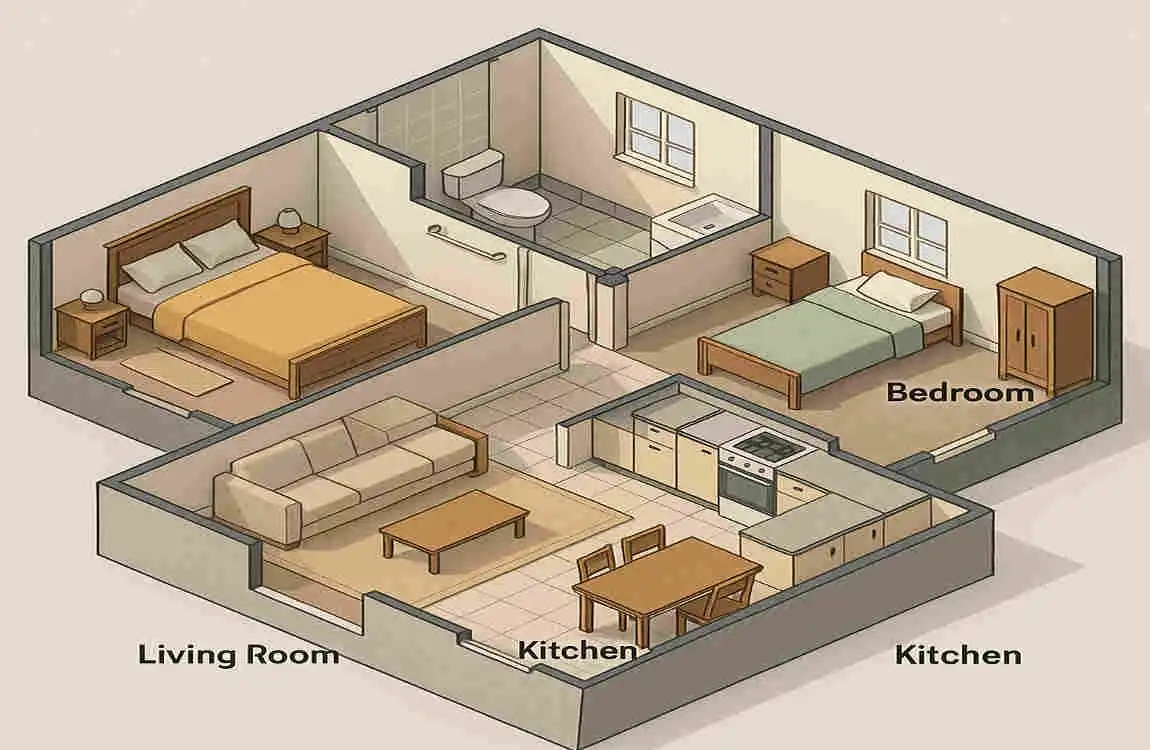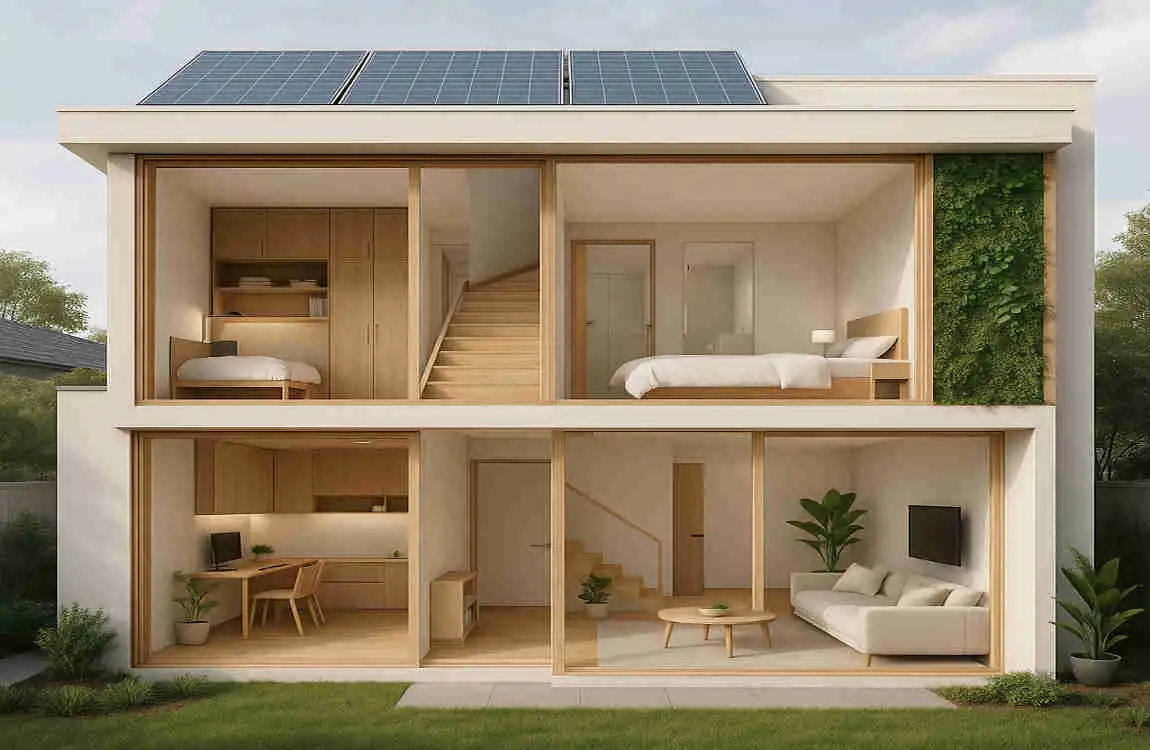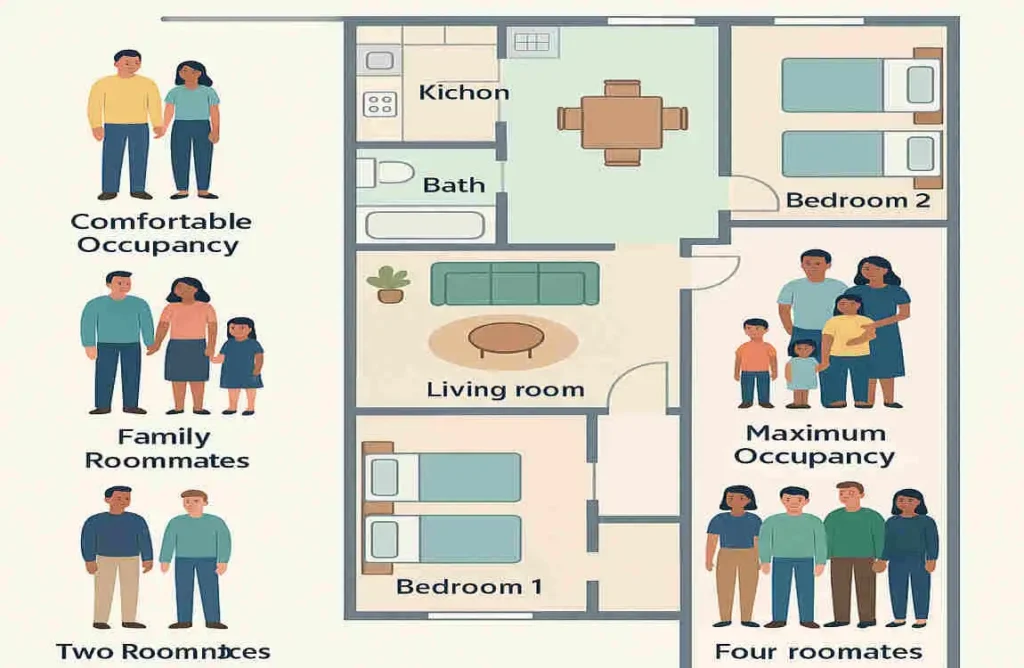When it comes to finding the perfect home, understanding living capacity is crucial. Whether you’re a growing family, a couple looking for more space, or a single person wanting to downsize, knowing how many people can comfortably live in a 2-bedroom house is essential.
Why are 2-bedroom houses so popular? They strike the perfect balance between space and affordability, making them ideal for a wide range of living situations. From young families to couples and singles, a 2-bedroom house offers the flexibility to adapt to your changing needs.
Understanding the Basics of a 2 Bedroom House

Before we dive into living capacity, let’s start with the basics of a 2-bedroom house.
What is a 2 Bedroom House?
A 2-bedroom house is a residential property that features two separate sleeping areas, typically with a shared common space such as a living room and kitchen. These homes come in various shapes and sizes, from cozy apartments to spacious detached houses.
Typical Size Range
The size of a 2-bedroom house can vary significantly depending on the location and type of property. On average, you can expect a 2-bedroom house to range from 800 to 1,200 square feet. However, the size can vary depending on factors such as layout, ceiling height, and the presence of additional rooms or amenities.
Types of 2 Bedroom Houses
2-bedroom houses come in many different forms, each with its own unique features and benefits:
- Apartments: Often found in multi-story buildings, apartments offer a convenient and low-maintenance living option.
- Detached Houses: Stand-alone homes that provide more privacy and outdoor space.
- Townhomes: Attached homes that share walls with neighboring properties, offering a balance of space and affordability.
- Condos: Similar to apartments but with the added benefit of ownership and potential for appreciation.
Key Considerations
When evaluating a 2-bedroom house, it’s important to consider the following factors:
- Layout: The arrangement of rooms and common spaces can greatly impact the overall livability and flow of the home.
- Design: The style and aesthetic of the house can affect your comfort and enjoyment of the space.
- Amenities, such as a balcony, garage, or additional storage, can enhance the functionality and value of a 2-bedroom home.
Factors Influencing Living Capacity
Now that we have a solid understanding of what a 2-bedroom house entails, let’s explore the key factors that influence living capacity.
Space Allocation
The amount of space available in each room and the overall layout of the house significantly influence how many people can comfortably live in the house. Larger rooms and a more efficient layout can accommodate more occupants without feeling cramped.
Local Building and Occupancy Regulations
Different regions have their own set of rules and regulations regarding the maximum number of occupants allowed in a given space. These regulations are in place to ensure the health, safety, and well-being of residents. It’s essential to familiarize yourself with the local laws before determining the number of occupants for your 2-bedroom house.
Cultural and Lifestyle Differences
Living capacity can also be influenced by cultural norms and individual lifestyle preferences. Some cultures may prioritize larger families living together, while others may value more personal space. Additionally, factors such as work-from-home arrangements and hobbies can impact the amount of space required for comfortable living.
Age Groups and Specific Needs
The age and specific needs of the occupants can also affect living capacity. For example, young children may require less personal space but more shared living areas, while elderly individuals may need more space for mobility and accessibility. Similarly, those with disabilities may have unique requirements that need to be considered when determining the right number of occupants.
Privacy and Comfort Balance
Ultimately, it’s crucial to strike a balance between privacy and comfort when determining living capacity. While more occupants can help share the financial burden of housing, it’s important to ensure that each person has enough personal space and privacy to feel at home.
Standard Guidelines for Living Capacity
Now that we’ve explored the key factors influencing living capacity, let’s dive into some standard guidelines to help you determine the right number of occupants for your 2-bedroom house.
General Occupancy Standards
As a general rule of thumb, most experts recommend allocating at least 100 to 150 square feet of living space per person. This includes both private and shared areas, such as bedrooms, living rooms, and kitchens.
Recommended Number of Occupants per Bedroom
When it comes to bedrooms specifically, the recommended number of occupants varies depending on the room’s size and layout. Here are some general guidelines:
- Small bedroom (under 100 square feet): 1 person
- Medium bedroom (100-150 square feet): 1-2 people
- Large bedroom (over 150 square feet): 2-3 people
Suggested Maximum Occupancy
Based on these guidelines, the suggested maximum occupancy for a 2-bedroom house would be 4-6 people, depending on the size and layout of the home. However, this can vary based on local regulations and individual needs.
Comparison with Legal and Safety Regulations
It’s important to note that legal and safety regulations may differ from these general guidelines. For example, some regions may have stricter occupancy limits based on factors like fire safety and sanitation. Always check with your local authorities to ensure compliance with any relevant regulations.
Optimal Living Arrangements
Now that we have a better understanding of the factors influencing living capacity and the standard guidelines, let’s explore some optimal living arrangements for different scenarios.
Ideal Scenarios for 1-2 Persons
For individuals or couples, a 2-bedroom house offers plenty of space and flexibility. Here are some ideal scenarios:
- Single person: Use one bedroom as a private sleeping area and the other as a home office, guest room, or hobby space.
- Couple: Share one bedroom and use the other as a shared office, dressing room, or relaxation space.
Suitable Arrangements for Small Families (2-4 Members)
For small families, a 2-bedroom house can still provide a comfortable and functional living space. Here are some suitable arrangements:
- Couple with one child: Use one bedroom for the parents and the other for the child. Consider using a bunk bed or a loft bed to maximize space.
- Couple with two children: Use one bedroom for the parents and the other for the children. Consider using a bunk bed or trundle bed to accommodate both children in the same room.
Considerations for Shared Living (Roommates, Extended Family)
For those considering shared living arrangements, such as roommates or extended family members, a 2-bedroom house can still work well. Here are some key considerations:
- Roommates: Use one bedroom for each person, or consider sharing a larger bedroom and using the second bedroom as a shared office or living space.
- Extended family: Use one bedroom for the primary family and the other for extended family members, such as grandparents or adult children. Consider using a Murphy bed or sofa bed to maximize space.
How to Maximize Space Without Sacrificing Comfort
No matter your living arrangement, there are several ways to maximize space in a 2-bedroom house without sacrificing comfort:
- Declutter regularly: Keep only the essentials and donate or sell items you no longer need.
- Use multi-functional furniture: Invest in pieces that serve multiple purposes, such as a sofa bed or storage ottoman.
- Optimize storage: Utilize vertical space, under-bed storage, and closet organizers to maximize your storage areas.
- Create distinct zones: Use area rugs, curtains, or furniture placement to create distinct zones within a shared space, such as a living area and dining area in an open-concept layout.
Space Planning and Design Tips

Now that we’ve covered the basics of living capacity and optimal arrangements, let’s dive into some practical space planning and design tips to help you make the most of your 2-bedroom house.
Efficient Furniture Placement
The way you arrange your furniture can significantly impact the overall flow and functionality of your space. Here are some tips for efficient furniture placement:
- Measure your space: Before buying any furniture, measure your rooms and create a floor plan to ensure everything will fit comfortably.
- Consider traffic flow: Arrange your furniture to allow for easy movement throughout the space, avoiding obstacles and tight spaces.
- Use furniture to define zones: Use larger pieces of furniture, such as a sofa or bookshelf, to separate different areas of the room, such as a living area and dining area.
Multi-Purpose Rooms and Furniture
In a 2-bedroom house, it’s essential to maximize the use of every room and piece of furniture. Here are some ideas for creating multi-purpose spaces:
- Convertible furniture: Invest in pieces that can serve multiple functions, such as a sofa bed, daybed, or dining table that can be extended or folded away.
- Flexible room layouts: Consider using a room divider or curtain to separate a bedroom into two distinct areas, such as a sleeping area and a home office.
- Shared living spaces: Utilize the living room as a multifunctional space for entertaining, working, and relaxing by incorporating a comfortable seating area, a desk or table for work, and a media center for entertainment.
Storage Solutions to Optimize Space
Effective storage is crucial for maintaining a well-organized and clutter-free 2-bedroom house. Here are some storage solutions to help you optimize your space:
- Vertical storage: Utilize tall bookshelves, cabinets, or wardrobes to maximize your vertical space, keeping items off the floor and out of the way.
- Under-bed storage: Use storage bins or drawers under your bed to store items like seasonal clothing, extra bedding, or shoes.
- Closet organizers: Invest in closet organizers, such as shelving units, hanging organizers, or shoe racks, to maximize your closet space and keep everything tidy.
Privacy Zones within a 2-Bedroom Setup
Even in a smaller home, it’s important to create privacy zones to ensure everyone has a comfortable and quiet space to retreat to. Here are some ideas for creating privacy zones in a 2-bedroom house:
- Use room dividers: Use a folding screen, bookshelf, or curtain to separate a shared bedroom into two distinct sleeping areas.
- Incorporate soundproofing: Use area rugs, curtains, or acoustic panels to help absorb sound and create a more peaceful environment.
- Create a private nook: Use a cozy chair, floor lamp, and small table to create a private reading or relaxation nook in a corner of the living room or bedroom.
Common Mistakes and How to Avoid Them
When planning your 2-bedroom house, it’s essential to avoid common mistakes that can result in a cramped or dysfunctional living space. Here are some mistakes to watch out for and how to avoid them:
- Overcrowding: Avoid filling your space with too much furniture or decor, as this can make the room feel cramped and cluttered. Stick to the essentials and prioritize pieces that serve multiple functions.
- Ignoring natural light: Don’t block windows or natural light sources with heavy furniture or curtains, as this can make the room feel dark and gloomy. Use light-colored curtains or blinds to filter the light while maintaining privacy.
- Neglecting storage: Don’t overlook the importance of storage in a small space. Invest in storage solutions early on to keep your home organized and clutter-free.
Case Studies and Real-Life Examples
Now that we’ve covered the key factors, guidelines, and tips for determining living capacity in a 2-bedroom house, let’s examine some real-life examples and case studies to see how these principles are applied in practice.
Typical Living Layouts for Different Occupancy Levels
Here are some examples of typical living layouts for different occupancy levels in a 2-bedroom house:
- 1-2 occupants: One bedroom used as a primary sleeping area, with the second bedroom used as a home office, guest room, or hobby space.
- 2-4 occupants: One bedroom used for the primary family (e.g., parents and one child), with the second bedroom used for additional family members (e.g., a second child or grandparents).
- 4-6 occupants: One bedroom used for the primary family, with the second bedroom used for extended family members or roommates. Consider using bunk beds or trundle beds to maximize space.
Success Stories: Maximizing Space in Small Homes
There are many success stories of people who have successfully maximized space in small homes, including 2-bedroom houses. Here are a few examples:
- The Murphy Bed: One couple used a Murphy bed in their second bedroom to create a multi-purpose space that could serve as a guest room, home office, and relaxation area.
- The Loft Bed: A single person used a loft bed in their second bedroom to create a cozy sleeping area above a home office and storage space below.
- The Open-Concept Layout: A small family used an open-concept layout in their living room and kitchen to create a spacious and functional living area that could accommodate multiple activities and family members.
Legal Occupancy Limits in Various Cities/Countries
Legal occupancy limits can vary significantly depending on the city or country you live in. Here are some examples of legal occupancy limits in different regions:
- New York City: The minimum square footage per occupant is 80 square feet, with a maximum of 2 people per bedroom.
- London: The minimum square footage per occupant is 6.5 square meters (approximately 70 square feet), with a maximum of 2 people per bedroom.
- Toronto: The minimum square footage per occupant is 7 square meters (approximately 75 square feet), with a maximum of 2 people per bedroom.
Cost Implications of Different Living Arrangements
The cost implications of different living arrangements in a 2-bedroom house can vary depending on factors like location, size, and amenities. Here are some examples of how different living arrangements can impact costs:
- Single occupant: Lower utility and maintenance costs, but potentially higher rent or mortgage payments per person.
- Couple or small family: Shared utility and maintenance costs, with potentially lower rent or mortgage payments per person.
- Shared living with roommates or extended family: Lower utility and maintenance costs per person, with potentially lower rent or mortgage payments per person. However, this may come with trade-offs in terms of privacy and space.
Future Trends and Innovations in 2 Bedroom Housing (2025 Outlook)
As we look ahead to 2025, several exciting trends and innovations in 2-bedroom housing are expected to impact living capacity and comfort.
Smart Layouts and Space-Saving Technology
Smart layouts and space-saving technology are becoming increasingly popular in 2-bedroom houses. From modular furniture to built-in storage solutions, these innovations can maximize space and create a more functional and comfortable living environment.
Modular and Adaptable Home Designs
Modular and adaptable home designs are also on the rise, enabling homeowners to customize their living spaces to suit their evolving needs. From movable walls to convertible rooms, these designs offer flexibility and versatility in a 2-bedroom house.
Impact of Remote Work and Lifestyle Changes
The rise of remote work and lifestyle changes, such as a greater focus on health and wellness, are also influencing the design and living capacity of 2-bedroom houses. From dedicated home offices to outdoor living spaces, these trends are shaping the way we live and work in smaller homes.
Sustainability and Eco-Friendly Design
Finally, sustainability and eco-friendly design are becoming increasingly important in 2-bedroom housing. From energy-efficient appliances to green building materials, these features can help reduce the environmental impact of smaller homes while also saving money on utilities and maintenance.
Summary: How Many People Can Live in a 2 Bedroom House?
In this ultimate guide, we’ve covered everything you need to know about living capacity in a 2-bedroom house. From understanding the basics of a 2-bedroom home to exploring the factors that influence living capacity, we’ve provided standard guidelines, optimal living arrangements, and practical tips for maximizing space and comfort.
Key Points to Remember
- The size and layout of a 2-bedroom house can vary significantly, with an average range of 800 to 1,200 square feet.
- Factors like space allocation, local regulations, cultural differences, age groups, and privacy needs can all impact living capacity.
- As a general rule, aim for at least 100 to 150 square feet of living space per person, with a recommended maximum of 4 to 6 occupants in a 2-bedroom house.
- Optimal living arrangements depend on your specific needs and lifestyle, from single occupants to small families and shared living situations.
- Space planning and design tips, such as efficient furniture placement and multi-purpose rooms, can help you make the most of your 2-bedroom house.
Final Recommendations
When determining the right number of occupants for your 2-bedroom house, consider the following recommendations:
- Assess your individual needs and lifestyle to determine the ideal living arrangement for you and your family.
- Familiarize yourself with local building and occupancy regulations to ensure compliance and safety.
- Use space planning and design tips to maximize the functionality and comfort of your 2-bedroom home.
- Consider future trends and innovations in 2-bedroom housing to stay ahead of the curve and create a living space that meets your evolving needs.
